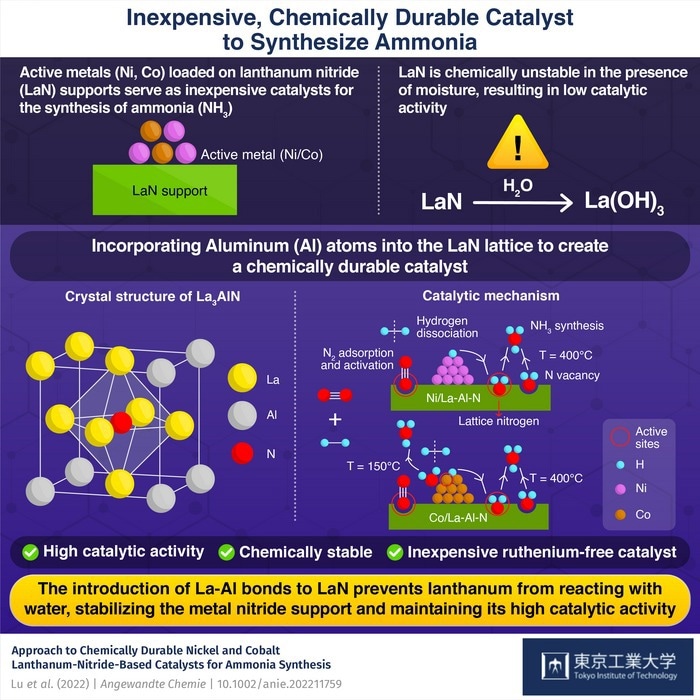Reviewed by Alex SmithOct 20 2022
The Haber-Bosch process, which is widely used to produce ammonia (NH3), the basis for synthetic nitrogen fertilizers, by blending hydrogen (H2) and nitrogen (N2) over catalysts at high pressures and temperatures, is among the most significant scientific discoveries that have helped to improve crop yields and boost global food production.

Image Credit: Tokyo Institute of Technology
However, owing to the process’s high temperature and pressure requirements, large fossil fuel energy inputs are required. The hydrogen used in this method is derived from natural gas (mainly methane). This hydrogen-production process consumes a lot of energy and emits carbon dioxide.
To address these concerns, several catalysts have been designed to allow the reaction to take place under milder circumstances using hydrogen generated by water electrolysis utilizing renewable energy. Nitride-based catalysts with active metal nanoparticles such as nickel and cobalt (Ni, Co) loaded on lanthanum nitride (LaN) substrates are among them.
Support and the active metal are involved in forming NH3 in these catalysts. The active metal divides the H2, whilst the LaN support’s crystal structure contains nitrogen vacancies and nitrogen atoms that adsorb and activate nitrogen (N2).
While these catalysts are cheap (since they do not need ruthenium, which is expensive), their catalytic activity suffers when exposed to moisture, with the LaN support changing into lanthanum hydroxide (La(OH)3).
Researchers from China and Japan, headed by Professor Hideo Hosono of the Tokyo Institute of Technology (Tokyo Tech), have discovered a chemically stable catalyst that is stable in the presence of moisture. The research was published in Angewandte Chemie journal.
Researchers integrated aluminum atoms into the LaN structure and produced a chemically stable La3AlN support comprising La-Al bonds that inhibit lanthanum atoms from reacting with moisture, drawing cues from stable rare-earth compounds having chemical bonds between a rare-earth metal (here La) and a metal.
When supplied with nitrogen gas-containing moisture, the La-Al-N support, combined with active metals like nickel and cobalt (Ni, Co), produced NH3 at rates comparable to standard metal nitride catalysts and could sustain a stable production.
The Ni- or Co-loaded La-Al-N catalysts showed no distinct degradation following exposure to 3.5% moisture.
Hideo Hosono, Professor, Tokyo Institute of Technology
While the Al atoms stabilized the support, the doped support’s lattice nitrogen and nitrogen defects permitted ammonia production in a manner similar to that of traditional active metal/rare-earth metal nitride catalysts.
Lattice nitrogen as well as nitrogen vacancy in La-Al-N play a key role in N2 adsorption, with the La-Al-N support and the active metal Ni being responsible for N2 and H2 absorption and activation, respectively.
Hideo Hosono, Professor, Tokyo Institute of Technology
The Haber-Bosch process is an energy-intensive chemical reaction that accounts for around 1% of global yearly CO2 emissions. While other ecologically friendly NH3 generation methods are being studied, incorporating affordable catalysts could bring beneficial results by permitting the process to function under milder conditions.
Journal Reference:
Lu, Y., et al. (2022) Approach to Chemically Durable Nickel and Cobalt Lanthanum-Nitride-Based Catalysts for Ammonia Synthesis. Angewandte Chemie International Edition. doi.org/10.1002/anie.202211759.